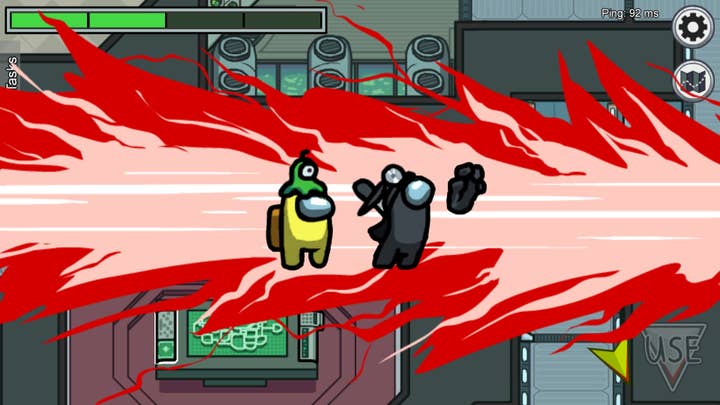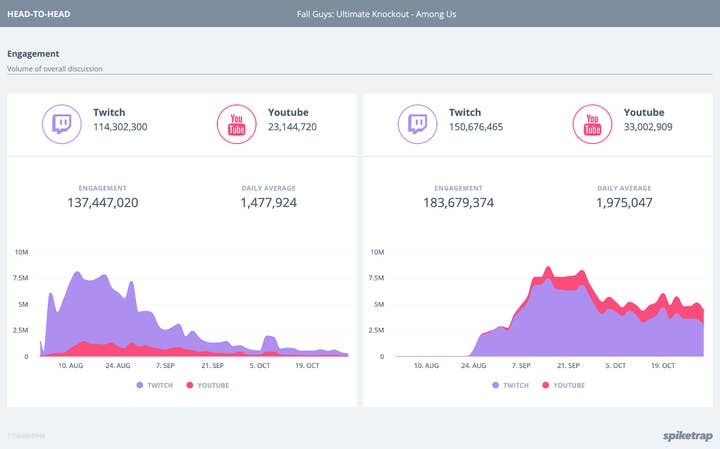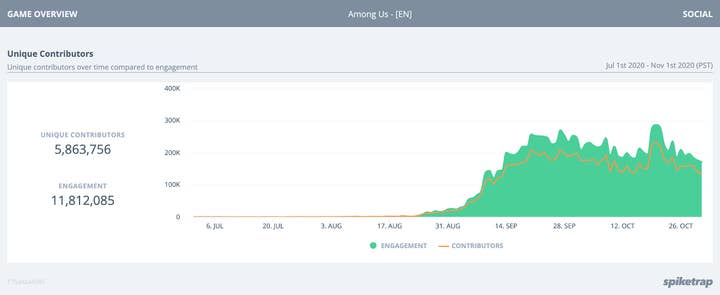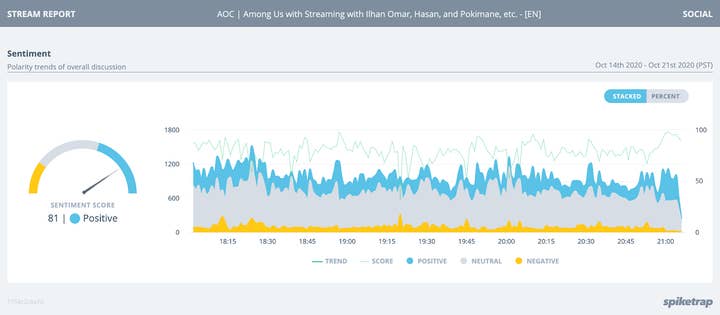Conversation as the crewmate: Understanding the rise of Among Us
Barbie Koelker from conversation analysis platform Spiketrap explores Among Us' growing popularity
On the surface, the rise of any overnight indie sensation may be bewildering, particularly when the tidal wave hits two years after launch. This was the case for Among Us, a cross platform game by InnerSloth.
While much has been written about the game in recent weeks -- and while many of us have gleefully accused our friends and coworkers of being "sus" -- how early could we have seen the inevitability of its success?
For those paying attention to audience conversations over the summer, the answer is pretty early. Moreover, the nature of the continued conversation around Among Us suggests that the game has staying power, even as it navigates the tumultuous waters that come with rapid growth.
The nature of the continued conversation around Among Us suggests that the game has staying power
Diving into Spiketrap data -- which applies natural language processing to organic conversations across over 400 online sources -- we can see what has driven exponential growth in audience awareness, engagement, and sentiment for Among Us, and we can see what this may mean for the game going forward. Let's dive in.
Falling into favor
No analysis of the rise of Among Us would be complete without a discussion of Fall Guys. Many popular streamers who played Fall Guys heavily at that game's launch listened to audience feedback that they should consider playing and streaming Among Us. As a result of these influencers being influenced by their own audiences, many have since incorporated Among Us into their broadcast mix, introducing hundreds of thousands of viewers to the otherwise obscure title for the first time.
As both games offer cartoonish graphics with jellybean-inspired character models, lighthearted competition, and a way to socialize with friends, the transition from broadcasting Fall Guys to Among Us was quite natural for streamers and their audiences alike.

Indeed, audiences were keen to engage with Among Us streams, and streamers were quick to capitalize on that engagement. By the end of August, an average of 330 people were broadcasting significant streams of Among Us each day, with significant being defined as any stream that reached at least 20 concurrent viewers. Already, this trend was interesting, and astute influencers were quick to hop on the Among Us spaceship, even if the media wouldn't take notice for another month.
By mid-September, influencer interest in streaming Among Us had swelled, with 1,949 significant Among Us streams on September 18 alone. Throughout September, anyone interested in watching Among Us gameplay found themselves with 1,121 options to choose from on any given day.
No analysis of the rise of Among Us would be complete without a discussion of Fall Guys
For their effort, streamers were rewarded with highly-engaged audiences. Examining the 20 most influential Among Us streamers in recent months, 21% of their audience engagement was directly tied to Among Us broadcasts. For streamers looking to maintain audience interest as they rotate between games, this share of engagement is an important metric.
Telling of both the broadcast hours devoted to Among Us and the responsiveness of streamer communities, engagement share among this cohort of streamers peaked in September at 49%, before subsequently tapering off to 12% in October. While this decline may be alarming at first blush, it is important to note the relative staying power compared to its jellybean counterpart and other flavor of the month titles.
Thus, an interesting shift happened over late August through early September. Audience conversations for Fall Guys fell while Among Us conversations rose, as illustrated in the head-to-head charts below.

Notably, while much of the conversation around Fall Guys took place on Twitter, Among Us has enjoyed more conversation volume tied to livestreams and VODs of gameplay. Given the slower, more dramatic pace of Among Us, higher levels of conversation amid gameplay are to be expected. That said, the proximity of the conversation to the game itself may be a driver in both positivity and staying power.
Another indicator that Among Us may be around for a while rests in the number of unique contributors to conversations circling the game outside of streams. After all, while conversation levels across livestreams may fluctuate in accordance with broadcast hours, conversations that persist outside of these environments indicate audience interest more broadly.
In this vein, many games we monitor have conversation contribution peaks that last for only a few weeks after launch. However, Among Us has enjoyed a relatively consistent chorus since it entered favor in late August.

Over the last week in August, we measured an average of 13,746 unique contributors to the Among Us conversation each day. By September, that figure had grown 9.7X to 133,552. Where most games would see their conversation sources subsequently taper, Among Us has enjoyed continued growth. Specifically, unique contributors rose another 25% in October, achieving a daily average of 166,670.
If Among Us is able to maintain this elevated rate of unique conversation contributors for a third month, it will be fair to expect the game to maintain notable levels of popularity for some time to come.
Positively engaging
Clearly, people continue to engage with Among Us, and conversations pertaining to the game are thriving. Why is this? Delving into the trending topics pertaining to the game uncovers some answers.
The vast majority of the conversations pertaining to Among Us have to do with in-the-moment gameplay commentary. Is Orange sus?
First, the vast majority of the conversations pertaining to Among Us have to do with in-the-moment gameplay commentary. Is Orange sus? Was that Blue who vented? Why was an emergency meeting called? While there are admittedly conversation threads discussing frustrations with game servers or the seemingly impromptu Among Us stream hosted by United States Congresswoman Alexandria Ocasio-Cortez, the majority of discussions are laser-focused on the player-created drama of any given game.
As such, overarching audience sentiment remains positive. Where the tenor of other multiplayer games may suffer from heated discussions of game balance in a way that could reflect negatively on the developer, Among Us leaves such choices in the players' control, redirecting any heated discussions around the appropriate imposter cooldowns to a group of friends.
A platform for persuasion
Given the relative breathing room both in the gameplay and viewership experience of Among Us, perhaps it is thus no surprise that the game is emerging as a platform for weaving in promoted messages.
For instance, consider AOC's stream of Among Us on October 20. In addition to being one of the most-watched Twitch streams ever hosted by an individual, the event was overwhelmingly positive, highly engaging, and effective from a campaign messaging perspective.

With respect to audience sentiment, the event generated significant positive engagement both within the stream chat and across other channels where conversations erupted. Typically, any conversation that yields a sentiment score of 60 or higher on the Spiketrap platform is considered to be positive. AOC's stream of Among Us generated a broadcast chat sentiment score of 81, and a rather impressive halo sentiment of 81 across other channels.
Among Us can provide streamers with a casual yet engaging environment
Moreover, and something that potential sponsors of Among Us streamers should consider, was the stream's ability to drive positive conversation around their core message for the event: to drive voter enthusiasm. For instance, our analysis of emotes used within Twitch chat for the broadcast revealed that the "All in to Vote" emote accounted for 22% of all emotes used. Likewise, conversations pertaining to voting -- particularly commentary around voting "blue" or for Biden -- were the most prominent threads of the night and generated a positive audience sentiment score of 66.
In short, the event showcased how Among Us can provide streamers with a casual yet engaging environment wherein they can naturally weave in promotional messaging while maintaining positive audience interactions. It's a perfect recipe for influencers and sponsors alike, which bodes well for the game to continue to receive a steady dedication of broadcast hours.
A flurry of feedback
Of course, the conversation for any game is never completely positive, and a developer's ability to understand and adequately respond to user feedback can greatly affect its staying power. When it comes to Among Us, its newfound fanbase is happy to provide feedback.
While interest in sabotaging communications within the game may vary, communications between players of Among Us and its creators have accelerated at a fever pitch. In July, the game received an average of 72 user reviews per day across the App Store, Google Play, and Steam. As of October, that figure had grown to 11,672, an increase of 11,600 user reviews every single day.

As the tidal wave of user reviews have poured in, there expectedly has been some criticism. A quick exploration into 50,0000 recent reviews of the game reveals that server reliability and security against hackers remain a concern. While the latter is only applicable to public games, frustrations over hacking have appeared in 45% of recent reviews for Among us. Prior to recent hacking concerns, the greatest complaints people had about the game were around server reliability and frustrations with trying to connect.
Nonetheless, overall audience sentiment as expressed in user reviews has remained overwhelmingly positive, even as its player base has swelled. Indeed, of the 622,349 Among Us reviews given between July 1 and October 31 and assessed by the Spiketrap platform, 83% have been positive and only 12% have been negative.
Looking ahead
The success of any game can be as uncertain as choosing who to throw out of an airlock. Developers can stumble just as easily as their players can lose a round. Still, even the most unexpected games with the humblest of origins can thrive when they not only generate positive conversation, but when they also take the time to listen.
To that end, the conversations around Among Us suggest that the oxygen isn't running out of the game any time soon -- even if it does run out during individual rounds. And, while the game is arguably going through growing pains, InnerSloth has already shown that it is listening to audience feedback and is willing to complete the tasks necessary to improve. As the game rolls out an account system to both empower friendships and reduce toxicity, we expect to see the conversation become even richer over the months ahead.
Indeed, from the first streamer who took heed of audience suggestions to play Among Us to the continued interactions between the game's fanbase and its developers, conversation has served as the crewmate keeping the hype engine humming.
Barbie Koelker is VP of marketing at Spiketrap, where she leads communications and marketing efforts for the rapidly growing conversation analytics platform, defining its voice, crafting its story, and driving discovery. Koelker is a communications and marketing leader with over 15 years experience fostering brand growth.








